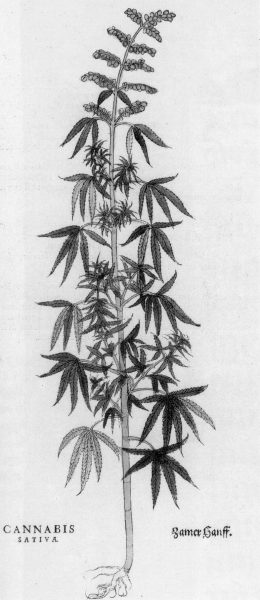
Leonhart Fuchs (1501-1566)
On May 10, 1566, German Botanist Leonhart Fuchs passed away. Fuchs is best known for authoring a large book about plants and their uses as medicines, i.e. a Herbal Book, published in 1542 in Latin, with about 500 accurate and detailed drawings of plants printed from woodcuts.
Leonhart Fuchs – Early Years
Leonhart Fuchs was born in Wemding, near Donauwörth, Swabia, the son of the mayor of Wemding, Hans Fuchs († 1505). After schooling in his home town of Wemding, in Heilbronn and in Erfurt, Fuchs studied philosophy and natural science at the University of Erfurt in 1515. In 1516 he returned to Wemding, where he opened a private school, but closed it only a year later. In 1519, he studied Greek, Latin and Hebrew as well as philosophy at the University of Ingolstadt under the humanist and Hebraist Johannes Reuchlin. In 1521, he was awarded the Magister Artium teaching license and began studying medicine in Ingolstadt in the same year. In 1524 he became a doctor of medicine.
Professor of Medicine in Tübingen
1524/25 he practiced as a doctor in Munich and taught medicine in Ingolstadt from 1526. In 1528, after conflicts with the conservative Catholic leadership, he entered the service of the Ansbach Margrave George the Pious as a personal physician. In 1531 he was again appointed to Ingolstadt, but returned to Ansbach in 1533. In 1535, appointed by Duke Ulrich von Württemberg, he received a professorship of medicine at the University of Tübingen, where he was rector seven times (1536, 1540, 1546, 1549, 1554, 1560, 1564) and lived with his large family in the still existing “Nuns’ House”. He conducted botanical excursions and laid out a medicinal plant garden, the first botanical garden of the university and one of the oldest in the world[1] Emperor Charles V raised it to the nobility.
One of the Fathers of Botany
Fuchs is regarded as one of the fathers of botany, as the main representative of New Galenism. Like his medieval predecessors and his contemporaries, Fuchs was heavily influenced by the three Greek and Roman writers on medicine and materia medica, Dioscorides, Hippocrates, and Galenus. He wanted to fight the Arab hegemony in medicine, as it had been transmitted by the Medical School of Salerno, and to “return” to the Greek authors. But he saw the importance of practical experience as well and offered botanical field days for the students, where he demonstrated the medicinal plants in situ. He has written over 50 books and polemics. He owes his great fame primarily to his herbal books, early textbooks of pharmacognosy.
The History of Plants
Leonhart Fuchs’ probably most famous book is titled De Historia Stirpium comentarii insignes (or Notable Commentaries on the History of Plants) and was published in 1542 after around 30 years of work. Prior to Fuchs’ efforts it was mostly uncommon to base herbal descriptions on scientific observation and rather base them on folk traditions. Fuchs was enthusiastic about illustrating plants and hired three men to help him with his work: Albrecht Meyer who specialized in drawing the plants, Heinrich Füllmaurer who was responsible for transferring the drawings into woodcuts, and Vitus Rudolph Speckle who was appointed to cut the blocks and print the illustrations.

Cannabis sativa from Leonhart Fuchs’s De De Historia Stirpium.
The resulting book was intended as a guide to plant collection and contains 497 plants illustrated, in enormous detail, hand-colored. The plants were ordered alphabetically according to their Greek names, since the botanical Latin had not yet existed. With this work, Fuchs set new standards for botanical illustrations. Due to the level of detail, the illustrated plants could be used in the field of medicine and could be correctly identified in nature. Further, Leonhart Fuchs also included 12 New World plants such as maize, kidney bean, chili pepper, cactus, and tobacco.
Aftermath
After his death, the extensive manuscript with more than 1500 plant pictures reached the Austrian National Library in Vienna, where it has been preserved in its entirety to this day. On the other hand, only a few copies of his herb book plates have survived. Charles Plumier named the genus Fuchsia of the plant family of the evening primrose family (Onagraceae) in his honour. Carl von Linné later adopted this name,[4,5] The standard author abbreviation L.Fuchs is used to indicate this person as the author when citing a botanical name.
Leonhard Fuchs died in Tübingen in 1566. The botanical genus Fuchsia is named in his honour, and consequently the colour fuchsia.
Aboca Museum – L’erbario De historia stirpium di Leonhart Fuchs, [9]
References and Further Reading:
- [1] Leonard Fuchs at Botanical Art and Artists
- [2] De Historia Stirpium by Leonhart Fuchs at Missouri Library
- [3] The Three Founders of Botany
- [4] Royal Botanist Charles Plumier, SciHi Blog
- [5] How a Cobbler became the ‘Princeps Botanicorum’ – Carl Linnaeus, SciHi Blog
- [6] Leonhart Fuchs at Wikidata
- [7] De Historia Stirpium Commentarii Insignes (German edition, 1542). From Rare Book Room.
- [8] “Leonhart Fuchs”. Iowa State University
- [9] Aboca Museum – L’erbario De historia stirpium di Leonhart Fuchs, Aboca Italia @ youtube
- [10] August Hirsch: Fuchs, Leonhart. In: Allgemeine Deutsche Biographie (ADB). Band 8, Duncker & Humblot, Leipzig 1878, S. 169 f.
- [11] Gernot Rath: Fuchs, Leonhart. In: Neue Deutsche Biographie (NDB). Band 5, Duncker & Humblot, Berlin 1961, ISBN 3-428-00186-9, S. 681 f.
- [12] Timeline of Pre-Linnaean Botanists, via DBpedia and Wikidata






Pingback: Whewell’s Gazette: Year 3, Vol. #39 | Whewell's Ghost